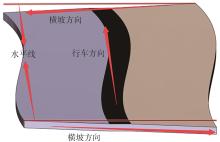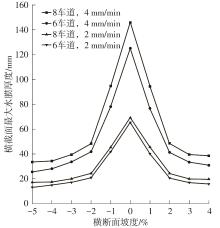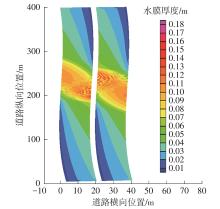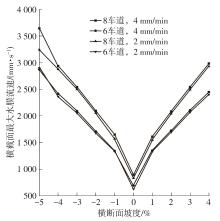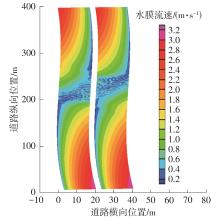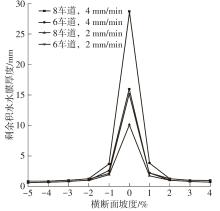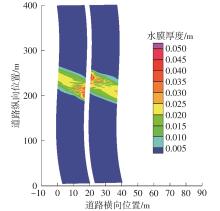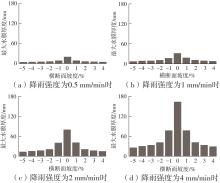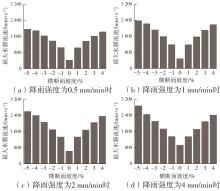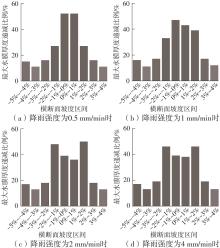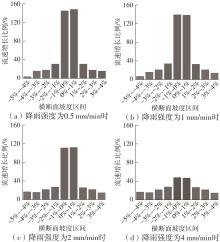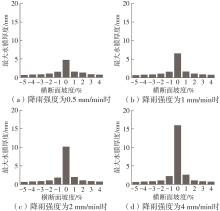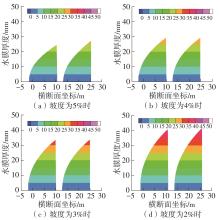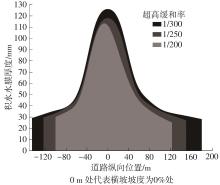Journal of South China University of Technology(Natural Science Edition) ›› 2024, Vol. 52 ›› Issue (8): 56-64.doi: 10.12141/j.issn.1000-565X.230505
Special Issue: 2024年交通运输工程
• Traffic & Transportation Engineering • Previous Articles Next Articles
Analysis of Water Accumulation Characteristics on S-Curve of Highway Based on Numerical Simulation
WU Wenliang ZENG Weikai LI Zhi WANG Xiaofei
- School of Civil Engineering and Transportation,South China University of Technology,Guangzhou 510640,Guangdong,China
-
Received:2023-08-01Online:2024-08-25Published:2024-02-09 -
Contact:李智(1971—),男,博士,副教授,主要从事道路工程研究。 E-mail:lizhi@scut.edu.cn -
About author:吴文亮(1981—),男,博士,副教授,主要从事沥青路面研究。E-mail: ctwlwu@scut.edu.cn -
Supported by:the Natural Science Foundation of Guangdong Province(2022A1515011974)
CLC Number:
Cite this article
WU Wenliang, ZENG Weikai, LI Zhi, et al. Analysis of Water Accumulation Characteristics on S-Curve of Highway Based on Numerical Simulation[J]. Journal of South China University of Technology(Natural Science Edition), 2024, 52(8): 56-64.
share this article
Table 1
Relationship table of velocity, curve radius, and superelevation values"
| 超高值/% | 120 km/h | 100 km/h | ||||
|---|---|---|---|---|---|---|
| 10% | 8% | 6% | 10% | 8% | 6% | |
| 2 | 5 500(7 550)~2 950 | 5 500(7 550)~2 951 | 5 500(7 550)~2 952 | 5 500(7 550)~2 954 | 5 500(7 550)~2 955 | 5 500(7 550)~2 956 |
| 3 | 2 950~2 080 | 2 860~1 990 | 2 730~1 840 | 2 180~1 520 | 2 150~1 480 | 2 000~1 320 |
| 4 | 2 080~1 590 | 1 990~1 500 | 1 840~1 340 | 1 520~1 160 | 1 480~1 100 | 1 320~920 |
| 5 | 1 590~1 280 | 1 500~1 190 | 1 340~970 | 1 160~920 | 1 100~860 | 920~630 |
| 6 | 1 280~1 070 | 1 190~980 | 970~710 | 920~760 | 860~690 | 630~440 |
| 7 | 1 070~910 | 980~790 | 760~640 | 690~530 | ||
| 8 | 910~790 | 790~650 | 640~540 | 530~400 | ||
| 1 | 张卓,高建平 .考虑水流路径长度的S型曲线超高段纵坡研究[J].重庆交通大学学报(自然科学版),2013,32(4):594-596,691. |
| ZHANG Zhuo, GAO Jianping .Longitudinal slope at super-elevation sections of S curve considering flow path length[J].Journal of Chongqing Jiaotong University (Natural Science),2013,32(4):594-596,691. | |
| 2 | 贾兴利,陈星澎,黄平明,等 .高速公路超高过渡段几何线形对小型客车滑水速度的影响[J].交通运输工程学报,2022,22(4):140-147. |
| JIA Xing-li, CHEN Xing-peng, HUANG Ping-ming,et al .Influence of geometric alignment of expressway superelevation transition section on hydroplaning speed of minibus[J].Journal of Traffic and Transportation Engineering,2022,22(4):140-147. | |
| 3 | 王豈 .基于轮胎-路面-水流耦合模型透水沥青路面抗滑性能研究[D].长沙:长沙理工大学,2022. |
| 4 | 季天剑,黄晓明,刘清泉,等 .道路表面水膜厚度预测模型[J].交通运输工程学报,2004,4(3):1-3. |
| JI Tian-jian, HUANG Xiao-ming, LIU Qing-quan,et al .Prediction model of rain water depth on road surface[J].Journal of Traffic and Transportation Engineering,2004,4(3):1-3. | |
| 5 | 罗京,刘建蓓,王元庆 .路面水膜深度预测模型验证试验[J].中国公路学报,2015,28(12):57-63. |
| LUO Jing, LIU Jian-bei, WANG Yuan-qing .Validation test on pavement water film depth prediction model[J].China Journal of Highway and Transport,2015,28(12):57-63. | |
| 6 | YANG W C, TIAN B J, FANG Y W,et al .Evaluation of highway hydroplaning risk based on 3D laser scanning and water-film thickness estimation[J].International Journal of Environmental Research and Public Health,2022,19(13):7699/1-18.. |
| 7 | 张理 .易积水路段的诊断与防治技术[D].重庆:重庆交通大学,2013. |
| 8 | 管朝鹏 .基于DPM及EWF模型的积水分布研究[D].重庆:重庆交通大学,2015. |
| 9 | 赵建有,郭万江,贾兴利,等 .多车道高速公路超高过渡段积水分布数值模拟与规律分析[J].交通运输工程学报,2022,22(2):187-196. |
| ZHAO Jian-you, GUO Wan-jiang, JIA Xing-li,et al .Numerical simulation and law analysis of water accumulation distribution at superelevation transition section of multilane expressway[J].Journal of Traffic and Transportation Engineering,2022,22(2):187-196. | |
| 10 | WANG K, LI P, AI Q,et al .Study on water distribution characteristics of surface gathered water and water film thickness model[J].Alexandria Engineering Journal,2022,61(4):3293-3302. |
| 11 | 吴建军,袁成松,周曾奎,等 .短时强降雨对能见度的影响[J].气象科学,2010,30(2):274-278. |
| WU Jianjun, YUAN Chengsong, ZHOU Zengkui,et al .Impact of short-term heavy rainfall on the monitoring and forecast of sudden visibility descent[J].Scientia Meteorologic Sinica,2010,30(2):274-278. | |
| 12 | 辛俐 .重型商用车侧窗区域水污染的ELM-ELFM仿真及均衡化控制研究[D].长春:吉林大学,2021. |
| 13 | DING H B, ZHANG Y, SUN C Q,et al .Numerical simulation of supersonic condensation flows using Eulerian-Lagrangian and Eulerian wall film models[J].Energy,2022,258:124833/1-18. |
| 14 | BHUIYAN A A, NASER J .Development of 3D transient wall filming mechanism during combustion by coupling Eulerian-Lagrangian approach and particle-wall interaction model[J].Applied Thermal Engineering,2017,112:911-923. |
| 15 | SHI L G, TAO L L, ZHANG Y X,et al .CFD simulations of wind-driven rain on typical football stadium configurations in China’s hot-summer and cold-winter zone[J].Building and Environment,2022,225:109598/1-19. |
| [1] | HU Xingjun, LUO Yufei, ZHANG Jinglong, et al.. Influence of Inflow Direction on Thermal-Hydraulic Performance of Louvered Fin-Common Flow Down Vortex Generator [J]. Journal of South China University of Technology(Natural Science Edition), 2023, 51(7): 12-20. |
| [2] | ZHANG Yihan WANG Ping HU Jingfeng. Analysis of Nonlinear Rolling Damping and Rolling Motion of Asymmetric Catamaran [J]. Journal of South China University of Technology (Natural Science Edition), 2021, 49(7): 26-33. |
| [3] | YING Rui, JIANG Jin, LI Yanhui, et al. Analysis of Flow Filed Characteristics and Particle Classification Performance of Inner Cone Hydrocyclone [J]. Journal of South China University of Technology (Natural Science Edition), 2020, 48(4): 95-103. |
| [4] | . Transfer Function Representation of Dynamic Circulating Flow Rate of Torque Converter [J]. Journal of South China University of Technology (Natural Science Edition), 2016, 44(7): 22-28. |
| [5] | Wang An-lin Cheng Wei Cao Yan Liu Wei-guo. Momentum Distribution Method of Blades of Hydraulic Torque Converter with Circumferential Uniform Acceleration [J]. Journal of South China University of Technology (Natural Science Edition), 2015, 43(9): 135-140. |
| [6] | Yuan Xian-ju Guo Kong-hui . Investigation into Opening of a Pilot Relief Valve Located in a Semi-Active Damper#br# [J]. Journal of South China University of Technology (Natural Science Edition), 2015, 43(8): 91-98. |
| [7] | Gong Jin- ke Wang Yun- ke Jia Guo- hai. Simulation and Experimental Research on Performance of Decompression Engine Brake [J]. Journal of South China University of Technology (Natural Science Edition), 2014, 42(9): 140-146. |
| [8] | Wang Shuo Su Yu-min Du Xin. Numerical Simulation of Planing Crafts Sailing in Calm Water and in Waves [J]. Journal of South China University of Technology (Natural Science Edition), 2013, 41(4): 119-126. |
| [9] | Liu Jia-xin Qin Si-cheng Xu Zhen-yuan Zhang Ao Xi Yu Zhang Xue-lin. Comparative Analysis of Heat Exchange Performance of Vehicle Radiator Based on CFD Numerical Simulation [J]. Journal of South China University of Technology(Natural Science Edition), 2012, 40(5): 24-29. |
| [10] | Yan jun-wei Liu yang Zhou xuan Kang ying-zi. Energy-Saving Optimization of Air Conditioning Terminal Device Based on Numerical Simulation [J]. Journal of South China University of Technology(Natural Science Edition), 2012, 40(4): 144-149. |
| [11] | Chen Ke-fu Zeng Jin-song Feng Yu-cheng Li Jun. Flow and Simulation of Pulp Fiber Suspensions [J]. Journal of South China University of Technology(Natural Science Edition), 2012, 40(10): 20-27. |
| [12] | Zeng Jin-song Chen Ke-fu Li Jun Xu Jun. CFD-Based Investigation into Flow Field of S-Type Discharger at the Bottom of High-Consistency Pulp-Bleaching Tower [J]. Journal of South China University of Technology (Natural Science Edition), 2011, 39(1): 24-29. |
| [13] | Wu Jia-ming Deng Wei Lai Hua-wei . Numerical Simulation of Hydrodynamic Characteristics of Ducted Propeller in Turning Motion [J]. Journal of South China University of Technology (Natural Science Edition), 2010, 38(7): 90-96. |
| [14] | Zhang De-man Li Shun-ming Men Xiu-hua . CFD Investigation into Pressure Loss of Single-Cylinder Engine Muffler [J]. Journal of South China University of Technology (Natural Science Edition), 2010, 38(3): 129-132. |
| [15] | Xiao Yi-qing Li Chao Ou Jin-ping Song Li-li Li Qiu-sheng. CFD Approach to Evaluation of Wind Energy in Complex Terrain [J]. Journal of South China University of Technology (Natural Science Edition), 2009, 37(9): 30-35. |
| Viewed | ||||||
|
Full text |
|
|||||
|
Abstract |
|
|||||
